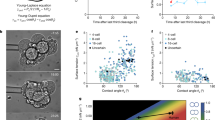Abstract
ALTHOUGH there are reports of satisfactory lambing after artificial insemination with frozen ram semen1–4, most investigators have obtained disappointing results (reviewed by Emmens and Robinson5 and Sadleir6). It has been claimed7 that frozen ram spermatozoa penetrate to the cranial part of the cervix more slowly than those from fresh semen. In an experiment8 with a limited number of animals, cervical insemination yielded only unfertilized eggs (eight ewes), and although after tubal insemination fertilized eggs were recovered from all three ewes examined, only two out of seven ewes lambed. We have conducted two experiments with frozen semen—the first at the McCaughey Memorial Institute, Jerilderie (Table 1) and the second on a private property at Yass, NSW (Table 2).
This is a preview of subscription content, access via your institution
Access options
Subscribe to this journal
Receive 51 print issues and online access
$199.00 per year
only $3.90 per issue
Buy this article
- Purchase on Springer Link
- Instant access to full article PDF
Prices may be subject to local taxes which are calculated during checkout
Similar content being viewed by others
References
Mackepladze, I. B., Gugusvili, K. F., Bregadze, M. A., and Haratisvili, G., Zivotnovodstvo, 22 (2), 77 (1960).
Kalev, G., and Venkov, T., Fourth Intern. Cong. Anim. Reprod. Hague, 4, 972 (1961).
Lopatko, M. I., Zivotnovodstvo, 24 (10), 86 (1962).
Vlachos, K., and Tsakalof, P., Bull. Physiol. Path. Reprod. Artif. Insem. Thessaloniki, 1, 71 (1965).
Emmens, C. W., and Robinson, T. J., The Semen of Animals and Artificial Insemination (edit. by Maule, J. P.), chap. 12, 205 (Technical Communication No. 15, Commonwealth Bureau of Animal Breeding and Genetics, Edinburgh, 1962).
Sadleir, R. M. F. S., Laboratory Practice, 15, 413 (1966).
Lopyrin, A. I., and Loginova, N. V., Ovcevodstvo, 4 (8), 31 (1958).
Loginova, N. V., Ovcevodstvo, 8 (8), 20 (1962).
Nagase, H., and Niwa, T., Fifth Intern. Cong. Anim. Reprod. A.I., Trento, 4, 410 (1962).
Quinlivan, T. D., and Robinson, T. J., The Control of the Ovarian Cycle in the Sheep (edit. by Robinson, T. J.), chap. 13 (Sydney University Press, 1967).
Mattner, P. E., Austral. J. Biol. Sci., 16, 688 (1963).
Salisbury, G. W., J. Gerontol., 20, 281 (1965).
Lopyrin, A. I., Loginova, N. V., and Zeltobrjuk, N. A., Ovcevodstvo, 11 (3), 3 (1965).
Quinlivan, T. D., Martin, C. A., Taylor, W. B., and Cairney, I. M., J. Reprod. Fert., 11, 379 (1966).
Mattner, P. E., and Braden, A. W. H., Austral. J. Exp. Agric. Anim. Husb., 7, 110 (1967).
Salamon, S., Austral. J. Exp. Agric. Anim. Husb. (in the press).
Author information
Authors and Affiliations
Rights and permissions
About this article
Cite this article
SALAMON, S., LIGHTFOOT, R. Fertilization and Embryonic Loss in Sheep after Insemination with Deep Frozen Semen. Nature 216, 194–195 (1967). https://doi.org/10.1038/216194a0
Received:
Revised:
Issue Date:
DOI: https://doi.org/10.1038/216194a0
Comments
By submitting a comment you agree to abide by our Terms and Community Guidelines. If you find something abusive or that does not comply with our terms or guidelines please flag it as inappropriate.



